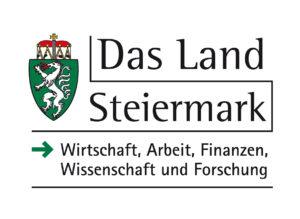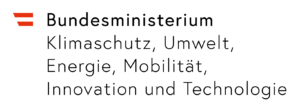Green Utopia - made in Green Tech Valley
We dream it, so we can do it!
Green Utopia - made in Green Tech Valley 2024
When carbon busters combat toxic gases in the atmosphere, when moulded components grow directly from trees or when bacteria as “employees” in industry ensure clean production, then this is Green Utopia – made in Green Tech Valley 2024. Eight short videos show how strong research at the site is making a green future possible.
The climate crisis requires a rapid rethink and innovative solutions. In the second edition of the cross-university and cross-cluster project “Green Utopia – made in Green Tech Valley”, teams of students from local colleges and universities have once again translated current high-tech research at the location into utopian and visionary short videos. Eight utopias were presented on the big stage today at the high-calibre award ceremony.
Why utopias? The purposeful dreaming that is made possible in this way harbours massive power for the upcoming energy, mobility and resource turnaround. The visions combine technological research and social change. They include the production of hydrogen from pollutants, the use of cyanobacteria for green materials, the suburbs as climate sponges for water and heat, nature as a legal entity, plastic-free compost, wood as a high-tech material, rails as an electric motorway and plant-based blood vessels from the printer. Today’s utopias are tomorrow’s reality
“More and more technologies based on disruptive research for a green future are coming from Europe, especially from Green Tech Valley in the south of Austria. These utopias make economic courage inwardly and excellent research outwardly internationally visible,” says Green Tech Valley Managing Director Bernhard Puttinger. The short videos were created by teams of students from FH Joanneum, TU Graz, the University of Graz and the University of Leoben together with Creative Industries and Holzcluster Steiermark. These are now being widely communicated internationally in a campaign. Eberhard Schrempf, Managing Director of Creative Industries Styria: “Utopias are the reality of tomorrow, according to the motto: We dream it, so we can do it!”
The videos for Green Utopia 2024 Young designers visualize visionary, green research at the site
“IMAGINE: High-tech grows on its own
… Enabled by revolutionary wood tech for cars, batteries & more“
Green Utopist: Paul Krassnitzer, Uni Graz
Video-Team Institut für Design & Kommunikation – FH Joanneum: Bernadette Pößnicker, Hannah Milchrahm, Jakob Hirscher & Sarah Anna Molinari
Multiple cascading uses of wood
Lightness, flexibility & sustainability
The idea of multiple cascading uses of wood is transforming industries and creating a future where environmental sustainability takes center stage. The innovative use of wood in technology products reduces fossil fuel consumption, maximizes CO2 sequestration and takes an important step towards a greener and more sustainable world. In this utopia, wood is no longer just a building material, but a symbol for the intelligent use of resources and for innovations that respect and protect our environment. für Umweltsystemwissenschaften, Uni Graz
Research at the site
· Research at the Institute of Timber Engineering and Wood Technology, Technical University Graz
https://www.tugraz.at/en/institutes/lignum/research/research-focuses
· Center of Sustainable Construction, TU Graz https://www.tugraz.at/en/research/research-at-tu-graz/research-centers/graz-center-of-sustainable-construction
· CARpenTiER – Modelling, Production and further Processing of Eco-Hybrid Structures and Materials: https://www.carpentier.at/index.html
· Vehicle Safety Institute, TU Graz: https://www.tugraz.at/en/institutes/vsi/research/research-projects/active-research-projects
“IMAGINE: Nature as a legal person
… Enabled by research on rights for all for a new life in harmony“Green Utopist: Victoria Yavorskaya, Uni Graz
Video-Team Institut für Design & Kommunikation – FH Joanneum: Alice D’Aiuto, Antonia Sophia Marie Muszi, Hanna Weichsler, Laura Galvanetto & Lisa-Marie König
Nature receives personal rights
In the future, an alternative economic model will emerge that is based on a revolutionary concept concept: nature is granted legal personal rights that guarantee it the right to exist, thrive and regenerate. Inspired by existing approaches in Latin America, this model goes far beyond this and places the relationship between the economy, society and the environment on a completely new basis.
In this utopian scenario, nature is no longer seen as a mere resource to be utilized and exploited, but rather to be used and exploited, but as an essential partner with its own rights. Companies and private individuals have a legal obligation to consider the impact of their actions on the and ensure that their activities do not violate the rights of nature. This is leading to a profound change in the way economic decisions are made and is forcing decisions are made and forces all players to place sustainability and environmental protection at the environmental protection at the heart of their strategies.
Participation of civil society
Another key element of this model is the active participation of civil society and indigenous communities in indigenous communities in decisions that affect the environment. The involvement of these groups in the decision-making process ensures that a variety of perspectives are taken into perspectives are taken into account and the deep connections between people and their natural are recognized. This promotes a culture of coexistence and respect for nature that goes far beyond the boundaries of traditional economic models.
In this utopia, recognizing the rights of nature leads to a world where economic progress and environmental protection go hand in hand. Companies flourish because of their innovative and sustainable approaches, while at the same time natural ecosystems are protected and regenerated. Society is developing a new awareness of the importance of nature, which is reflected in a respectful and responsible approach to the environment.
This alternative economic model shows a way for humanity to live in harmony with nature and create a sustainable future for all living beings on our planet.
Research at the site
· Research Center for Climate Law – ClimLaw: Universitiy of Graz: https://climlaw.uni-graz.at/en/
· Department of Environmental Systems Sciences, University of Graz: https://ess.uni-graz.at/en/
IMAGINE: Food without micro-plastic
… Enabled by new compost handling technologies for a healthy life”Green Utopist: Josef Adam, Montanuniversität Leoben
Video-Team Institut für Design & Kommunikation – FH Joanneum: Alvina Vass, Elisa Kroiss, Jan Wohlmuth & Maximilian Kathan
Biogenic waste without plastic as a contaminant
In the future, we will experience a revolution in composting – the era of “plastic-free compost”. This ambitious project aims to improve the quality and quantity of compost through a cycle-oriented approach to the individual processes – from collection to pre-processing and to post-processing – to significantly improve the quality and quantity of compost. The central challenge is to to make the removal of the contaminant plastic more efficient in order to minimize the environmental impact and increase the quality of the compost.
Biogenic waste, the basis for high-quality compost, is an essential component of a functioning circular economy. However, the increasing problem of plastics, especially microplastics, poses a growing challenge for the organic cycle. Plastics in compost not only jeopardize soil quality, but also enter our food chain.
Innovative cycle-oriented processes
In this utopia, the amount of plastic in biogenic waste is reduced through innovative, cycle-oriented processes. This includes better pre-treatment for more effective separation of plastics and improved post-treatment methods to further optimize the separation. Traditional shredders and screens in pre-treatment are complemented by advanced technologies and advanced screening and air separation methods are used in post-treatment. A particular focus is on the research and development of sensor-based sorting techniques that enable more precise separation of plastics. This project goes beyond traditional composting and integrates scientific findings in order to optimize the understanding and improving the transformation of plastics during composting.
Research at the site
· Chair of Waste Processing Technology and Waste Management
https://pure.unileoben.ac.at/en/organisations/chair-of-waste-processing-technology-and-waste-management-515
“IMAGINE: Peri-urban areas as sponge
… Enabled by research to deal with extreme weather in a PERI-fect future “Green Utopist: Mario Stefan, TU Graz
Video-Team Institut für Design & Kommunikation – FH Joanneum: Helene Gödl, Katharina Mundigler, Maike Klemm & Tina Zopf
The reinvention of peri-urban spaces as sponge areas
The year 2050 marks an era in which cities and urban areas have become resilient oases in the face of climate change. Thanks to the pioneering research project PeriSponge, peri-urban mobility spaces have been transformed into life-giving sponge areas. Previously threatened by floods, droughts and biodiversity loss, these areas are now characterized by a now revitalized by a blue-green transformation. The once clear boundaries between city and nature are blurring in a harmonious interplay of resilience and regeneration.
In this new world, public spaces, designed according to the principle of blue-green transformation, have become vital components of urban landscapes. They not only offer protection from extreme weather events, but also promote urban biodiversity and create cool, shady shady havens in the midst of urban heat islands. Streets and squares, once gray and sealed, are now living, green arteries that absorb rainwater, provide habitats and improve the microclimate.
Efficiency and quality of life in sponge cities
Advanced technologies and sustainable design are seamlessly intertwined in this future to maximize maximize efficiency and quality of life in these sponge cities. Smart water management systems, controlled by artificial intelligence, regulate water flow and storage to prevent flooding and survive periods of drought.
Photocatalytic surfaces and integrated solar technology help to purify water and air while at the same time generating energy for public facilities. The 2050 vision shows peri-urban areas as vibrant, green networks that interweave cities and landscapes. Sponge areas that store rainwater and and prevent flooding have become the norm. These green corridors not only serve ecological balance, but also as invigorating, communal spaces that invite people to linger and increase the well-being of city dwellers.
People and nature in harmony
In this utopian future, every initiative, every project is a step towards a world in which sustainable coexistence is a reality. PeriSponge is an example of this transformation, a symbol of a future in which humans and nature live together in perfect harmony.
Research at the site
Potentials of peri-urban mobility spaces as sponge territories for climate change adaptation and mitigation, Technical University of Graz
https://www.tugraz.at/en/fakultaeten/architektur/research/research-projects/perisponge
“IMAGINE: Cyanobacteria work for industry
… Enabled by replacing chemicals with organic processes for a greener planet”Green Utopist: Peter Erlsbacher, TU Graz
Video-Team Institut für Design & Kommunikation – FH Joanneum: Anna-Katharina Hammerer, Sofia Neudecker & Tea Mauko
Cyanobacteria as green catalysts
In the future, we will have achieved a groundbreaking turnaround in the chemical industry. The heart of this revolution are cyanobacteria, which act as green catalysts and offer an environmentally friendly alternative to traditional chemical processes. Cyanobacteria are able to produce enzymes that are needed to carry out
electron transfers (redox reactions). This makes it possible to carry out complex redox processes efficiently and in an environmentally friendly manner without the need for expensive and environmentally harmful catalysts or energy-intensive conditions.
Of particular note is the production of NADPH, a molecule that is widely distributed in nature and can power many different redox reactions. Research has found a way to effectively recycle this expensive molecule by using cyanobacteria, which are able to recycle NADPH directly from water using light energy, resulting in oxygen as the only waste product.
Integration into industrial processes
In our utopia, these genetically optimized cyanobacteria are used on a large scale to catalyze a variety of chemical reactions in a way that is both economically and ecologically sustainable. They enable the production of pharmaceuticals, plastics and many other important chemicals without the environmentally damaging side effects associated with traditional methods.
Another key advantage of this technology is its ability to be stereoselective, which means that they can specifically produce one of the two mirror images of a molecule. This
This precision is particularly invaluable in the pharmaceutical industry, where the wrong isomer of a drug can have harmful effects. The ability to specifically produce the desired form of a molecule is revolutionizing drug manufacturing, facilitating the safe and effective production of new therapies. The integration of cyanobacteria into industrial processes has not only transformed chemical production, but has also established a new sector of green technologies based on the coexistence of industrial development and environmental protection. Industrial plants that were once among the biggest polluters are now pioneers in the use of renewable energy and the minimization of greenhouse gas emissions.
This is a shining example of how innovative research and respectful treatment of nature can pave the way to a future worth living for all living beings on our planet.
Research at the site
- Field of Expertise Human & Biotechnology, TU Graz
https://www.tugraz.at/en/research/fields-of-expertise/human-biotechnology/overview-human-biotechnology/ - ACIB – Austrian Centre of Industrial Biotechnology
https://acib.at/ - Functional Diversity & Ecology, “Climate Change”, University of Graz
https://climate-change.uni-graz.at/en/research-fields/functional-diversity-ecology/
“IMAGINE: Plants as blood vessels
… Enabled by revolutionary & patient-specific 3D-prints from organic materials for more health“
Green Utopist: Florian Lackner, TU Graz
Video-Team Institut für Design & Kommunikation – FH Joanneum: Larissa Holweg, Lea Haas, Ramona Groß, Sophie Lautischer & Stefanie Weber
Inspired by the fundamental insight that nature is an irreplaceable partner in the development of sustainable technologies, researchers have developed a groundbreaking method to revolutionize healthcare in this utopia: the creation of plant blood vessels in the laboratory.
Our society, which is increasingly characterized by demographic change, is facing a growing demand for implants and organs that cannot be adequately met by conventional methods – using fossil, unsustainable materials or ethically questionable allo- and xenotransplants.
Inspired by this urgent need, researchers have developed a pioneering solution: the creation of exact, personalized replicas of blood vessels through the 3D printing of plant-based biopolymers. These biopolymers, derived from an innovative blend of alginate from brown algae and nanofibrillated cellulose from wood fibers, offer greater biocompatibility due to their natural origin, allow for patient customization and promote sustainability while reducing reliance on animal testing and xenotransplantation.
These artificial blood vessels are produced in specially developed 3D printers equipped with a rotating fourth axis. This innovation makes it possible to create tubular structures whose cellulose fibers can be aligned to mimic the complex fiber structure and anisotropic mechanical properties of natural tissues – such as those of a human aorta. This process is not only a demonstration of technical finesse, but also a testament to the ability to mimic and augment nature.
In this visionary future, 3D-printed, patient-specific blood vessels grown in the laboratory will offer a safe and sustainable alternative to conventional transplants. They eliminate the need for donor organs and the ethical dilemmas associated with animal testing, opening the door to a new era of medicine. An era in which technological progress and ecological responsibility go hand in hand..
Research at the site
· Institute for Chemistry and Technology of Biobased Systems, TU Graz https://www.tugraz.at/institute/ibiosys/home
“IMAGINE: CarbonBusters turn toxic into good
… Enabled by depolarized electrolysis – from flue gas to products & green hydrogen“
Green Utopist: Lukas Rössler, TU Graz
Video-Team Institut für Design & Kommunikation – FH Joanneum: Alexandra Suváková & Mariam Gvivradze
Depolarized electrolyzers
In this vision, the question is why be carbon-neutral when you can be carbon-negative with green hydrogen. The most common method for producing green hydrogen is water electrolysis, which is already widely known but energy-intensive.
In the SHyRE project, researchers at TU Graz are working on innovative, depolarized electrolysers. To make them work, a toxic gas from the atmosphere or from industrial gas waste is used to depolarize the electrolysis cell. In this way, the same purity of hydrogen is produced with less energy consumption. A highly valuable by-product (instead of O2 in conventional electrolysis) is produced in large quantities. By removing impurities from the atmosphere or process streams, depolarized electrolysis actively reduces the amount of greenhouse gases emitted and converts them into a valuable compound. And all this while producing high-purity H2 at the same time.
This technology looks like a competitor to the traditional water electrolyzer, but in reality should be a coexisting alternative for a variety of industries that need to clean up their emissions: Mining plants, biorefineries, pharmaceutical and plastics industries.
Research at the site
- SHyRE – Sulfuric acid and hydrogen production for the electronics industry through innovative recycling, TU Graz
https://nachhaltigwirtschaften.at/en/projects/circular-economy/SHyRE.php - Institute of Chemical Engineering and Environmental Technology, TU Graz
https://www.tugraz.at/institute/ceet/home
“IMAGINE: Bye highway. Hello e-railway!
… Enabled by fast pickup & charging tech taking e-cars on trains for relaxed mobility
Green Utopist: Armin Buchroither, TU Graz
Video-Team Institut für Design & Kommunikation – FH Joanneum: Anja Trummer, Max Frühwirt & Selma Kury
RailCharge
In a world where the challenges of electromobility are becoming urgent, the RailCharge utopia represents a visionary solution. Electric vehicles face the problem of limited ranges and long charging times, which, together with increasing traffic congestion and the need for sustainable resources for batteries, is an urgent problem. Electricity grids are also reaching their limits with fast charging at peak times.
RailCharge addresses this problem with the following idea: instead of equipping electric cars with ever larger batteries and promoting individual transport, electric cars are loaded onto trains using innovative, efficient loading systems and automatically charged during the journey using Matrix Charging®. This concept not only provides a solution to the existing limitations of electric vehicles, but also promotes emission-free mobility and reduces traffic load.
Electric vehicles are parked on train carriages at railway stations, with an innovative transfer system significantly minimising waiting and loading times for passengers. Flexible loading and unloading at intermediate stations is also important for success and comfort. This can be achieved by adapting existing wagon systems or by developing new wagon designs.
Matrix Charging® technology is used at each car parking space in the train carriage. This automated connection technology with the charging pad on the floor of each car parking space enables an efficient and flexible charging infrastructure.
An interface to the train’s energy management system ensures efficient energy distribution and grid-friendly charging. At the destination station, the vehicle is fully charged and picked up by the passengers ready to continue their journey. In the meantime, they spend a pleasant stay in train compartments.
An evaluation of customer acceptance and environmental impact has already been carried out in the project and has shown a high potential for realising this utopia.
RailCharge offers a new perspective on long-distance transport with electric vehicles by enabling the seamless integration of road and rail transport. RailCharge opens a new chapter in the history of mobility – a step towards a more efficient, sustainable and connected future: The motorway by rail
Research at the site
· Field of Expertise: Mobility & Production, TU Graz
https://www.tugraz.at/en/tu-graz/services/news-stories/planet-research/foe-mobility-production
Statements
‘Sustainable Systems' is TU Graz's greatest area of scientific strength. Here, researchers from all disciplines and faculties work together on complex challenges and research sustainable solutions. The spectrum of research topics ranges from future-orientated urban planning, innovative building technologies and the use of renewable energy sources to intelligent energy networks and green mobility. In disciplines such as railway research, hydrogen research or sustainable energy systems, TU Graz is one of the international research leaders. A location becomes a centre of innovation when it thinks and researches across disciplines, institutions and borders and works on solutions for major social challenges. Styria is such a place, where bright minds are uninhibited and inspired to research encouraging utopias. And initiatives like Green Utopia give them the stage."
Horst Bischof, Rector of Technical University Graz
The major challenges facing society in the areas of resource scarcity, climate, energy and the environment predominantly require the use of technical and scientific methods. The University of Leoben sees its task as making a significant contribution to overcoming these challenges through excellent research and high-quality education. One current project involves the construction of the new hydrogen centre, which will open in autumn. In future, this centre will conduct research at the highest level into the production of green hydrogen. Or in the field of recycling, where basic principles such as digital, sensor-based waste analysis and sorting technologies are being researched at a research facility. The University of Leoben has always been characterised by its networking and interdisciplinary cooperation. The Green Utopia project will further strengthen the location while benefiting the individual stakeholders. This project also offers space for visionary ideas and bold solutions."
Peter Moser, Rector of Montanuniversität Leoben
As a university of the future, FH JOANNEUM is convinced that green utopias are needed to make the future of our society worth living in. We encourage people to think ahead and conduct research into important topics such as digitalisation, health, climate change, energy and mobility. Students and lecturers at all our institutes are therefore already tackling future topics in a practical way: the Energy Lab and Mobility Lab at FH JOANNEUM in Kapfenberg are researching renewable energies and forms of mobility, among other things. Environmentally friendly aviation is the focus of the Aviation degree programme in Graz, sustainable tourism at the Institute of Health and Tourism Management at FH JOANNEUM in Bad Gleichenberg. And last but not least, our Information Design students deal with green utopias when they visualise the contents of the eight green research utopias of 'Green Utopia' in order to communicate them to the public."
Martin Payer, Managing Director of FH Joanneum
At the University of Graz, we provide answers to the questions of our time. For these major challenges, including digital change, social upheaval and the climate crisis, the University of Graz provides solutions and explanations that we bring to the people. For example, our researchers have achieved a breakthrough that could become a game changer for the plastics industry. Chemists have developed a fully recyclable, bio-based epoxy plastic. An innovation with major implications that combines environmental protection and economic efficiency. Scientists at the University of Graz are used to pushing the boundaries of the everyday and rethinking issues. For example, slowing down climate change requires the expertise of many disciplines: natural sciences, social sciences and law. We also cross borders in our collaboration with the universities on site: for example, with Graz University of Technology for 20 years in the NAWI Graz cooperation."
Peter Riedler, Rector of the University of Graz
The final of "Green Utopia 2024"
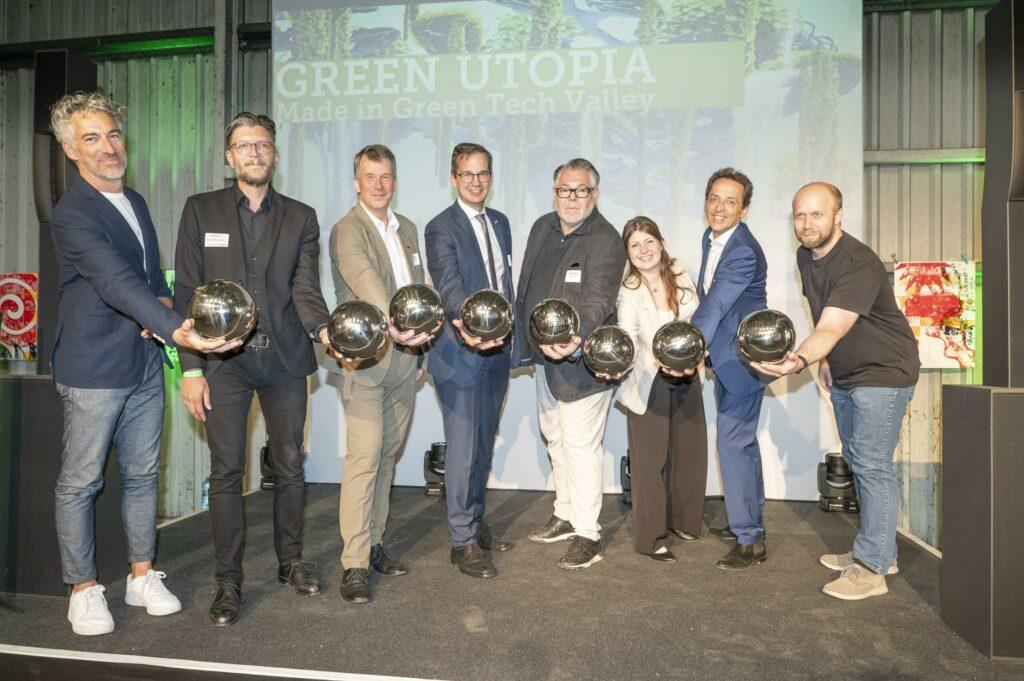
The Project: Green Utopia made in Green Tech Valley
Utopias are characterized by the unrealizable, the fantastic. But this is precisely where their massive power lies; these images of the future are what make revolutionary developments possible in the first place. “And the climate crisis, as well as the associated shift toward a comprehensive resource and circular economy, require almost utopian thinking in the same way,” Bernhard Puttinger, Managing Director of the Green Tech Valley Cluster, is convinced. “We have to be faster than climate change. That is the order of the day. This is where visions, this is where courage, this is where green solutions are needed.” And Green Tech Valley, as an international hotspot for green research & innovation, has a special significance in this regard, emphasizes Puttinger.
Cooperation for the green future
For this reason, forces were joined together with the Graz University of Technology, the Montanuniversity of Leoben, the Institute for Design and Communication of the Joanneum University of Applied Sciences, Creative Industries Styria and Holzcluster Steiermark. Eight interdisciplinary student teams produced green utopias here as short videos in the period from March to May 2023 as part of Designmonat Graz – visualizing a possible future of the energy, mobility and raw materials turnaround based on current research at the site. “Utopias grow into technologies here,” says Stefan Vorbach of Graz University of Technology enthusiastically of the results, which were presented in Graz on May 24. Illona Otto Wegener Center for Climate & Global Change (University Graz) points out to consider all social structures: “Green Utopia helps us to visualize and discuss the future ahead of us. If we know what the goal is, we can reach it faster.”
Visions spur innovation
The videos range from new post-consumer lifestyles and climate-positive construction to trees as electricity storage for stable grids. Utopian? From today’s perspective, quite so in some areas. “This in particular is an incentive for research and for companies in Green Tech Valley,” says Puttinger. Stefan Spirk (Graz University of Technology) also emphasizes this: “It is of immanent importance to imagine the unthinkable in order to be able to realize revolutionary technologies.” Sarah Meitz from AAE Intec – Institute for Sustainable Technologies also speaks of the courage to take new, radical paths, for example “in the production of hydrogen from wastewater and sunlight in solar reactors”: “Green utopias are needed to ensure climate-friendly and cost-effective energy supplies.”
Green Utopia 2023
Will trees store electricity in the future? Will we eat CO2 and store it in buildings? Will we change faster than the climate? Will we generate hydrogen directly from sunlight? What sounds utopian is being worked on at full speed in Green Tech Valley. Students from Graz University of Technology and the Institute for Design and Communication at Joanneum University of Applied Sciences have visualized current research results from Green Tech Valley into eight utopias of a green future as part of Designmonat Graz.
Presentation "Green Utopia" at Joanneumsviertel Graz









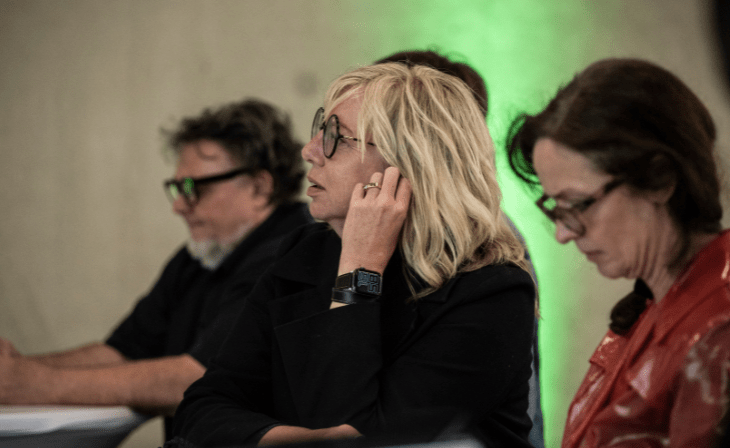
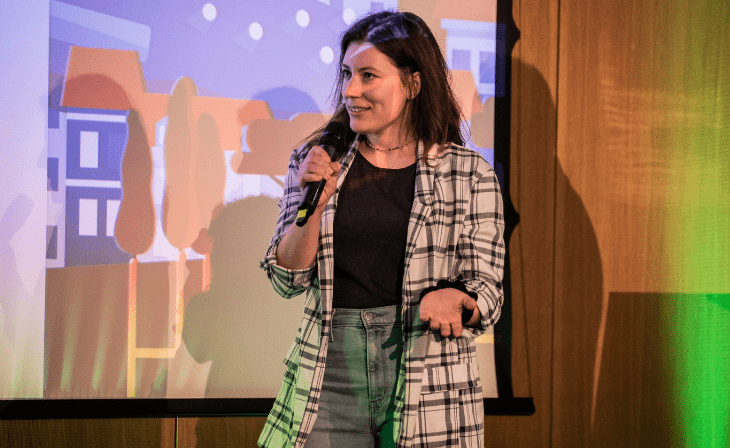
Making-of "Green Utopia made in Green Tech Valley 2023"
You are currently viewing a placeholder content from YouTube. To access the actual content, click the button below. Please note that doing so will share data with third-party providers.
More InformationWe proudly present:
Green Utopia 2023
Research behind the videos
“Imagine a future, where we store green power in trees … with the newly invented ORGANIC BATTERIES for stable power grids”.
Student statement: “This video depicts how energy could be saved in tress and provide every home with it.”
Digital twin turns grids into renewable energy storage systems
The transformation of the energy system requires a gigantic expansion of the production capacities of renewable energy generation plants. Keywords here are electrification, heat demand, but also hydrogen or synthetic energy sources.
The electricity, heat and gas networks have a key role to play here. They smooth out the fluctuations in consumption and generation over the course of the day and the year. Flexibly switchable prosumers (consumers & generators) such as stationary e-cars, appliances or industrial plants help in this process.
All prosumers such as private households with PV systems or larger energy communities are actively involved.
These are complemented by point source large scale storage. Large hot water tanks bring summer heat to winter district heating. Redox flow batteries (with novel electrolytes made from paper production waste) support hourly and daily grids.
The grids interact with each other so that heat, electricity and gas help each other out. Peak load power plants, so-called “peakers,” will also be needed in the future to support the grid. With the help of hydrogen as intermediate storage, these will become climate-neutral.
The “network as a flexible energy sponge” is made possible by the first digital twin of the European electricity and gas network, including heating networks. This prevents blackouts at an early stage through simulations and contributes to the full use of generation from renewable energies.
Highlight from Green Tech Valley:
Biobased redox float battery https://www.ecolyte.at
Research at the site:
Europe-wide digital twin of the power and gas grid
“Imagine a FUTURE where SUN fuels life … directly with the new PHOTOCATALYTIC COLLECTOR”
Student Statement: “This video demonstrates a new technology that can be used to obtain hydrogen directly through sunlight and what areas this could be useful for.”
Hydrogen directly from the sun moves ships, among other things, in a climate-neutral manner
The use of green hydrogen is a key building block in the future energy system as energy storage as well as an energy vector also for future marine and aviation.
So far, work is underway to produce hydrogen in sunny and windy parts of the world using PV and wind power via electrolysis and then convert it, e.g. as synthetic fuels. This is costly and inefficient.
In the future, direct photocatalytic production of hydrogen without electrolysis will be used, a game changer for the important building block of the energy system of the future.
Trials are underway at AEE Intec for this purpose. This means that in addition to solar collectors (heat), PV systems (electricity), solar reactors (hydrogen) will now be possible in the future. The overall efficiency increases massively with decreasing costs.
Shipping is indispensable in the global economic and transport system, but is one of the world’s largest CO2 emitters. 90 percent of large ships still use heavy oil as fuel.
Austria, a landlocked country, has the potential to put global shipping on a new green path and reduce emissions by 97 percent: green hydrogen is used as liquid methanol on the ship, the resulting CO2 is captured, stored on the ship, and reused on land for the production of methanol (i.e., used in a cycle).
Research in Green Tech Valley:
Large Engines Cometence Center LEC
Photocatalytic hydrogen production AAE INTEC
Decarbonization of shipping LEC
“Imagine a FUTURE with a FAIRYTALE life … using social TIPPING POINTS for faster climate action”
Statement of the students: “This video shows an awakening of society, which entails a fundamental change. Our values and norms have been strongly in tune with nature ever since.”
Faster than climate change
For all our faith in technological progress and the problem-solving abilities of Homo Sapiens, the news about natural disasters, weather extremes, the evident effects of climate changes that can already be measured, and the warnings of science force us to ask the central question: Can we still turn the tide quickly and effectively enough?
What picture of the future shows us that we were faster than climate change? That we have got a grip on the situation and have been able to steer the climate back towards more stable and livable paths?
On the one hand, it will be a matter of having won people over to the cause. So-called social tipping elements, on which the Wegener Center at KFU conducts research, will have captured people and brought them into action in a positive sense. Psychology and sociology as sciences can be an important key, and the use of new technologies such as artificial intelligence could also be a possibility to work here in the movement or activation of people. So everyone is pulling in the same direction.
Technically, however, it is also about scaling climate protection and circular economy solutions. The enormous amounts of energy, even with increasing energy and resource efficiency, must be produced in a 100% renewable way. To do this, technologies will become radically simpler and faster to use. New business models and a new way of doing business have revolutionized the world. An opportunity for the world, Europe, Austria, and especially the Green Tech Valley.
Styria & Carinthia were early pioneers in this field. More than 100 years ago, Viktor Kaplan invented the Kaplan turbine at the Graz University of Technology, the heart of the largest hydroelectric power plants in the world. And in the field of solar thermal energy, AEE pioneered a first wave for renewables with the self-assembly groups – the neighborhood joined in. With the first separate collection in Mureck, waste separation and thus recycling was widely started, especially in schools.
Research at the site
“Imagine a future society with zero waste … powered by 100% recycled batteries, organics & textiles”
Student Statement: “This video shows how we will achieve a waste-free future utopia through a 100% circular society. Innovative technologies such as self-healing substances and advanced recycling facilities will keep materials in circulation for as long as possible.”
100% circular society – A waste-free world through revolutionary approaches
Circular innovation is essential for a sustainable future. Consumption and modern life today are inextricably linked to waste. Packaging, surplus products, defective goods, food scraps and end-of-life products all contribute to the waste problem. However, waste is just a recyclable material in the wrong place. To enable a sustainable future, raw materials from the waste garbage can must be returned to the material cycle to enable a waste-free society.
No materials are disposed of after only a short period of use, but are kept in the cycle as long as possible through reuse, rethink, repair, remanufacture and also recycling processes.
In addition to the central, social dimension of a circular society, innovative technologies are also a building block: modern sorting plants that can ensure efficient separation of the various fractions, filter out materials that can still be reused, and allow the remaining substances to be used again in new ways through efficient chemical recycling.
Also, the development of self-healing materials that can repair themselves when damaged can extend the primary life of the product, contributing to a circular society. An extension of tracking individual materials is offered by digital product passports. These summarize all information about a product from components and materials to information about repairability & reuse.
New business models and distribution access such as leasing and sharing business models, product-as-a-service systems or performance-based contracting, can enable better maintenance and higher efficiency of use.
The renovation of buildings and the efficient recycling of construction waste are major contributors to the circular society. With digitalization as an important driver, e.g., through digital twin, which is updated throughout the life cycle, enabling a basis for later conversion and deconstruction measures.
Research from the Valley:
Chair of Waste Utilization Technology and Waste Management Montanuni Leoben
Institute for Structural Design (Building Recycling) TU Graz
“Imagine a future, where CO2 is on the plate, not in the atmosphere … powered by new bioreactors using recycled CO2 for sustainable food“
Student Statement: “The video showcases the dual potential of CO2: accelerating plant growth and transforming into protein powder for food production.”
Capture, store & use CO2 from various sources.
Climate change requires rapid and comprehensive reductions in CO2 emissions. In order to achieve the goal of “net zero emissions”, it is absolutely necessary to also bind CO2 emissions in order to cancel out remaining emissions in the balance sheet.
CO2 capture, especially from industrial or power plant waste gas streams, is already helping to reduce emissions. Andritz is currently scaling up a pilot plant for CO2 capture at cement plants. If biomass is burned instead of coal, a CO2 sink is created in the balance sheet.
Research at Graz University of Technology and the COMET Center BEST is investigating methods for additional production of green hydrogen from this process (bio-looping). Residual materials such as sewage sludge are also used in this process.
If the CO2 is then used as a material, emissions from the substituted products are again avoided. For example, acib and several startups are working on the extraction of proteins from CO2, which replace more climate-intensive animal feed. Methanation of CO2 via synthesis or hydrogenation processes also enables a sustainable energy carrier.
But farmers are also changing once again. With biogas & large PV plants they became “energy farmers”, in the future they will probably become CO2 sinkers: with the active build-up of the humus layer as carbon storage in the soil (especially by avoiding plowing, pilot region Kaindorf), with the introduction of biochar, i.e. charred biomass into the soil (research by BEST) as well as sustainably optimized forestry (special CO2 storage plants?).
Geological storage (cf. current prototypes in Denmark) will also be a building block on which little research is being done in Austria and which is not currently permitted here.
Highlights from the Valley:
Econutri – extracting proteins from CO2: https://econutri.com/
Andritz AG: Environmental solutions
Research at the site
BioLooping: https://www.tugraz.at/institute/ceet/research/hacker-group/projekt-uebersicht/bio-loop/
From Slurry to high-purity Hydrogen: https://www.tugraz.at/en/tu-graz/services/news-stories/tu-graz-news/singleview/article/von-guelle-zu-hochreinem-wasserstoff0
Protein research for industrial applications: https://acib.at/de/home/
“Imagine a FUTURE of climate-active BUILDINGS … that STORE CO2 in new materials and timber constructions”
Student statement: “This video shows how building with natural materials and modular wood structures could reduce construction waste and collect CO2 to release into the atmosphere.”
Buildings as CO2 reservoirs
Buildings are currently seen as part of the problem rather than part of the solution to a climate-neutral future. Many building materials such as concrete, bricks, etc. contain a lot of gray energy and thus also CO2 emissions. More than 10 percent of the climate-relevant emissions in Austria can be attributed to the building sector.
The future image “Building as CO2 storage” shows the building as CO2 sink instead of CO2 emitter. More CO2 is stored in buildings than is emitted during the production of building materials or the entire construction process. The building becomes climate positive.
Forests and trees store carbon in biomass, for example in wood. When wood is installed in the building, this carbon continues to be stored, provided that the entire timber industry is also managed sustainably, in a cycle. Wood construction is therefore an already existing lever. Through buildings, the raw material wood can be kept in the cycle for hundreds of years.
There is still a big lever in the CO2-free production of concrete and bricks. With energy efficiency and the use of renewable energies in production, the first step succeeds, the use of CO2 captured in the industry and the storage in these building materials themselves creates the actual sponge function. The building surfaces (facades & roof) themselves are active, either green or generating electricity & heat.
Research at the site:
Capture of CO2: https://www.vtiu-unileoben.at/en/news
Humus build-up in the soil as a CO2 sink: https://www.humusplus.at/
Institute for Building Physics TU Graz
Institute for Timber Engineering & Wood Technology TU Graz
Institute for Architecture and Civil Engineering
BEST – Bioenergy and Sustainable Technologies
“Imagine a FUTURE where cities are FORESTS … with organic surfaces producing green ENERGY”
Student Statement: “This video depicts the fusion of Graz with nature through various innovative developments and technologies, including sustainable energy production and vertical farming.”
Forest City
Nature and the city will no longer be mutually exclusive in the future. People are already aware that regeneration and health are to be sought in nature and that urban environments, as we know them today, tend to lead to stress and also health side effects.Green cities, or nature cities, can be thought of as forests in which nature and especially trees are given a very large space.
Furthermore, it is about area-wide organic, bioactive & energy-active surfaces (soils, facades, roofs, traffic routes) instead of sealed and passive surfaces. Here energy, food & oxygen is produced as well as water is stored.
CO2 sequestration is one function that the Nature City fulfills. The other is that of a city in which people feel comfortable because innovative and natural surfaces have a climatizing effect and produce oxygen. There are no more heat islands and the city is a CO2 sponge.
Energy efficiency and energy production including intelligent storage and distribution is part of the natural city. Food can also be produced directly in the city. On roofs and facades, in public spaces and through vertical farming, integrated into the other use functions of a city.
Nature is once again becoming a part of the reality of life for residents, and a sense of it is also being rekindled in schools. This additionally leads to more awareness for the protection of nature.
Research from the Valley:
Institute for Architecture and Landscape TU Graz
Institute for Urban Design TU Graz
“Imagine a FUTURE with relaxing MOBILITY … enabled by research on AUTONOMOUS and ELECTRIC mobility”
Student statement: “This video shows an autonomous transport system that makes the vision of a car-free city come true. The Modular Transportation System offers the benefits of a private vehicle and allows individual or shared use of the capsules. These integrate seamlessly with public transportation.”
Electr(on)ically mobile – “Beam me up, Scotty”
The transport sector is one of the main sources of greenhouse gas emissions. The highest share of emissions in the transport sector is attributable to road traffic, and in particular to passenger car traffic. In Austria, the transport sector is responsible for around 25% of CO2 emissions. But we also want to be mobile in the future. Travel also broadens horizons and connects us. So what does the mobility of the future look like beyond public transport, cycling, energy efficiency and electrification?
Digitization is a big key to making a certain kind of travel obsolete. Video conferencing has already become part of everyday life. Virtual and augmented reality applications can certainly make a difference here. New worlds and meeting spaces can be a way of traveling.
Research at Graz University of Technology helped make the Microsoft Hololens possible. Paired with the appropriate hologram technology, “holoportation” – that is, 3D travel from home – becomes possible. Or will Anton Zeilinger’s quantum research lead to “real” beaming after all? Crypto research from Graz will probably be in future quantum computers.
Electric mobility and other forms of propulsion can be a bridging technology to completely new, today still science fiction, approaches. Ecological lightweight hybrid materials may play a role here (Wood Vision of Mobility). From fossil-based materials to renewable materials with cycle-based eco design. CO2 storage with negative CO2 footprint of the materials used in mobility solutions. New design languages and regional value chains from the forest to mobility.
Highlights from the Valley:
Research at the location:
Institute for Computer Graphics and Vision TU Graz



